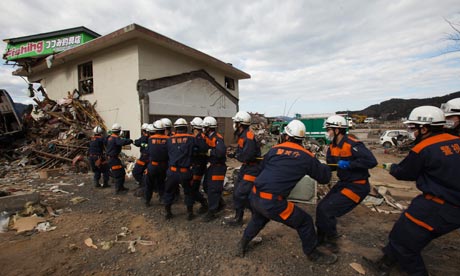Measures to stem leaks at Fukushima plant appeared to have failed, amid discovery of two bodies of men killed by tsunami

A senior Japanese official has warned that the crisis at the Fukushima Daiichi nuclear power plant could drag on for months, after another attempt to stem leaks of highly radioactive water appeared to end in failure.
Goshi Hosono, an aide to the prime minister, Naoto Kan, said everything possible was being done to contain radiation leaks, which have contaminated the environment and food and water supplies, prompted mass evacuations and fomented fear as far away as Tokyo, 150 miles to the south.
"We have not escaped from a crisis situation, but it is somewhat stabilised," Hosono said on television. Asked how long it would take to bring the plant's overheating reactors under control, he said. "I think several months would be one target."
The admission that there is no end in sight to the world's worst nuclear power accident since Chernobyl came after the recovery of two bodies inside the Daiichi plant. The workers were killed when it was struck by the 11 March tsunami. They were found last Wednesday, but had to be decontaminated before they could be handed over to relatives after almost three weeks of exposure to radiation.
The men, Kazhiko Kokubo, 24, and Yoshiki Terashima, 21, who were found in the basement of a reactor turbine building, died from multiple head injuries, reports said. Theirs were the first confirmed deaths at the Daiichi plant.
"It pains us to have lost these two young workers, who were trying to protect the power plant during the earthquake and tsunami," said Tsunehisa Katsumata, the chairman of Tokyo Electric Power [Tepco].
The size of the task facing about 600 workers, troops and firefighters at the plant was underlined at the weekend with the discovery of a 20cm crack in a concrete pit connected to the No 2 reactor. The leak generated radiation levels of 1,000 millisieverts an hour in the air inside the reactor, while Tepco said it could also be behind the seepage of radioactive iodine into the sea, sending contamination levels soaring to 4,000 times the legal limit.
Experts say that beyond the vicinity of the plant, there is minimal risk to human health in other parts of Japan or overseas.
After failed attempts to seal the crack by pouring concrete into the pit, workers have fed it with a water-absorbent polymer, along with sawdust and shredded newspaper, before topping the mixture with more concrete.
On Sunday evening, nuclear safety officials conceded that the polymer, which can expand to 50 times its normal size when combined with water, had made no impact on the water leakage, but added they would wait until Monday before deciding whether to abandon the approach.
"We were hoping the polymers would function like diapers, but we have yet to see a visible effect," said Hidehiko Nishiyama, a spokesman for Japan's nuclear and industrial safety agency.
He echoed the grim prognosis offered by Hosono. "It will take a few months until we finally get things under control and have a better idea about the future," Nishiyama said. "We'll face a crucial turning point within the next few months, but that is not the end of it."
Highly radioactive water has flooded the basement of the No 2 reactor and a connecting underground trench. The water in the cracked pit is thought to have come from partially melted fuel rods in the reactor's core.
In their battle to cool overheated reactors and prevent a dangerous meltdown of highly radioactive fuel rods, workers have doused reactors with huge quantities of seawater. The contaminated runoff, however, has prevented technicians and engineers from getting closer to the reactors to make proper repairs.
Fresh water is being pumped into No 1, 2 and 3 reactors using external power, Nishiyama said, adding that the remaining three reactors were considered stable.
More than 12,000 people are known to have died in the earthquake and tsunami, while 15,472 are missing, according topolice. More than 163,000 people are still living in evacuation shelter.
No comments:
Post a Comment